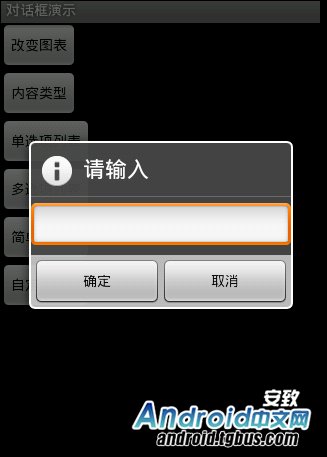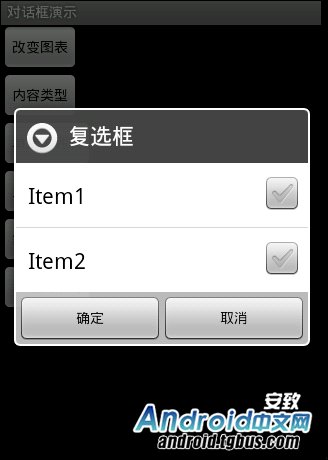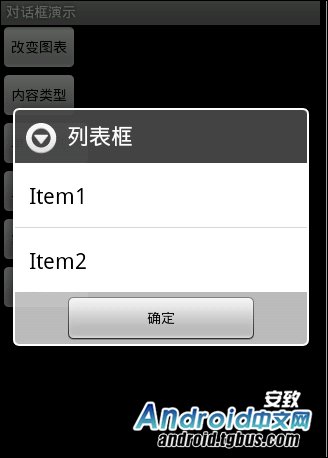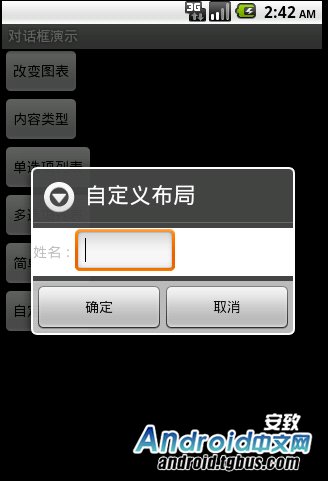来源:http://www.oschina.net/question/54100_32486
在 Android开发中,我们经常会需要在Android界面上弹出一些对话框,比如询问用户或者让用户选择。这些功能我们叫它Android Dialog对话框,在我们使用Android的过程中,我归纳了一下,Android Dialog的类型无非也就7种,下面我分别向大家介绍这7种Android Dialog对话框的使用方法,希望对大家能有所帮助。
1.该效果是当按返回按钮时弹出一个提示,来确保无误操作,采用常见的对话框样式。
创建dialog对话框方法代码如下:
1 2 3 4 5 6 7 8 9 10 11 12 13 14 15 16 17 18 19 | protected void dialog() { AlertDialog.Builder builder = new Builder(Main.this); builder.setMessage("确认退出吗?"); builder.setTitle("提示"); builder.setPositiveButton("确认", new OnClickListener() { @Override public void onClick(DialogInterface dialog, int which) { dialog.dismiss(); Main.this.finish(); } }); builder.setNegativeButton("取消", new OnClickListener() { @Override public void onClick(DialogInterface dialog, int which) { dialog.dismiss(); } }); builder.create().show(); } |
在onKeyDown(int keyCode, KeyEvent event)方法中调用此方法
1 2 3 4 5 6 | public boolean onKeyDown(int keyCode, KeyEvent event) { if (keyCode == KeyEvent.KEYCODE_BACK && event.getRepeatCount() == 0) { dialog(); } return false; } |
创建dialog的方法代码如下:
1 2 3 4 5 6 7 8 9 10 11 12 13 14 15 16 17 18 19 20 21 22 23 24 25 26 | Dialog dialog = new AlertDialog.Builder(this).setIcon( android.R.drawable.btn_star).setTitle("喜好调查").setMessage( "你喜欢李连杰的电影吗?").setPositiveButton("很喜欢", new OnClickListener() { @Override public void onClick(DialogInterface dialog, int which) { // TODO Auto-generated method stub Toast.makeText(Main.this, "我很喜欢他的电影。", Toast.LENGTH_LONG).show(); } }).setNegativeButton("不喜欢", new OnClickListener() { @Override public void onClick(DialogInterface dialog, int which) { // TODO Auto-generated method stub Toast.makeText(Main.this, "我不喜欢他的电影。", Toast.LENGTH_LONG) .show(); } }).setNeutralButton("一般", new OnClickListener() { @Override public void onClick(DialogInterface dialog, int which) { // TODO Auto-generated method stub Toast.makeText(Main.this, "谈不上喜欢不喜欢。", Toast.LENGTH_LONG) .show(); } }).create(); dialog.show(); |
创建dialog方法的代码如下:
1 2 3 4 | new AlertDialog.Builder(this).setTitle("请输入").setIcon( android.R.drawable.ic_dialog_info).setView( new EditText(this)).setPositiveButton("确定", null) .setNegativeButton("取消", null).show(); |
创建dialog方法的代码如下:
1 2 3 4 | new AlertDialog.Builder(this).setTitle("复选框").setMultiChoiceItems( new String[] { "Item1", "Item2" }, null, null) .setPositiveButton("确定", null) .setNegativeButton("取消", null).show(); |
创建dialog方法的代码如下:
1 2 3 4 5 6 7 8 | new AlertDialog.Builder(this).setTitle("单选框").setIcon( android.R.drawable.ic_dialog_info).setSingleChoiceItems( new String[] { "Item1", "Item2" }, 0, new DialogInterface.OnClickListener() { public void onClick(DialogInterface dialog, int which) { dialog.dismiss(); } }).setNegativeButton("取消", null).show(); |
创建dialog的方法代码如下:
1 2 3 | new AlertDialog.Builder(this).setTitle("列表框").setItems( new String[] { "Item1", "Item2" }, null).setNegativeButton( "确定", null).show(); |
dialog布局文件代码如下:
1 2 3 4 5 6 7 8 9 10 11 12 | <?xml version="1.0" encoding="utf-8"?> android:layout_height="wrap_content" android:layout_width="wrap_content" android:background="#ffffffff" android:orientation="horizontal" android:id="@+id/dialog"> <TextView android:layout_height="wrap_content" android:layout_width="wrap_content" android:id="@+id/tvname" android:text="姓名:" /> <EditText android:layout_height="wrap_content" android:layout_width="wrap_content" android:id="@+id/etname" android:minWidth="100dip"/> </LinearLayout> |
创建dialog方法的代码如下:
1 2 3 4 5 6 | LayoutInflater inflater = getLayoutInflater(); View layout = inflater.inflate(R.layout.dialog, (ViewGroup) findViewById(R.id.dialog)); new AlertDialog.Builder(this).setTitle("自定义布局").setView(layout) .setPositiveButton("确定", null) .setNegativeButton("取消", null).show(); |
好了,以上7种Android dialog对话框的使用方法就介绍到这里了,基本都全了,如果大家在android开发过程中遇到dialog的时候就可以拿出来看看。
另外注,本文参考文章:
http://android.tgbus.com/Android/tutorial/201107/359812.shtml







